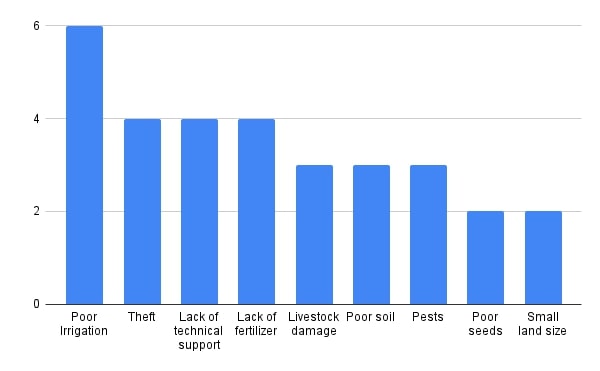By Nzube Ifediba

Nzube Ifediba is a global health researcher with an interest in global health and development research in Africa.
Over the years, Thrive for Good has seen how dramatically their gardens improve the lives of their beneficiaries, from improved health to increased earnings to strengthened community relationships.
But they wanted a thorough analysis of these benefits, so early this year, they contracted me and another researcher to investigate the economic impact of Thrive Life Gardens.
We first conducted a literature review to map what has been done before. What has been measured? How was it measured? How was the data collected? How was it analyzed?
We found that many community garden initiatives in Africa are ineffective. Africa has 65% of the world’s uncultivated arable land, which has huge potential, but there are challenges. Climate shocks, conflicts, and insufficient investment in agriculture slow down agricultural productivity. And it comes with a hefty cost. Currently, Africa spends about $78 billion on food imports each year.
Community gardens have the potential to not only provide food security, but also boost household earnings, increase productivity, and provide social protection to women. And it’s not something we say because of what we see at Thrive for Good. It’s right in the literature:
- Factors affecting food security of rural farmers in Lesotho
- Building Resilient and Profitable Smallholder Agricultural Systems in Sub-Saharan Africa
- The contribution of community gardens to food security in the Maphephetheni uplands
So why are a lot of garden initiatives ineffective? Out of the 30 garden initiatives we evaluated, only 12 had positive impacts on food security and nutritional outcomes. The other 18 had no impact, and in some cases, as many as 75% of participants still experienced food insecurity, despite the intervention.
Furthermore, only 10 had a positive impact on participants’ household income. To look for recurring trends, we mapped out the challenges these gardens faced. This table describes the recurring challenges:

Poor irrigation is the most common challenge. A lot of the initiatives required constant irrigation from pumps. This was neither cost nor energy efficient.
Theft is another challenge because many of the gardens were unfenced and located away from people’s homes. You can also see that failure to provide ongoing technical support to the participants was a problem, as were damage from livestock, pest infestation, and planting with poor quality seeds.
Not all the 30 initiatives we evaluated used organic farming methods. Many of the projects were described as “sustainable,” but on closer look, did not use organic methods. We discovered that an initiative was five times more likely to be impactful if it used organic methods.
What Thrive for Good Does Differently
Since 2008, we have helped African communities build sustainable organic gardens that provide nutritious food for consumption and income generation. These gardens employ biointensive gardening practices developed by Ecology Action and the Common Ground Project. The training material on bio-intensive methods is very substantial, but for this article, I will give a summary.
The biointensive method starts with deep soil preparation using the double-dig method, which involves digging the soil to two spade depths to improve soil structure, aeration, and loosen compact soil.
This method also employs a simultaneous use of organic composting to prepare the soil for planting. This method encourages the sustainable production of organic materials such as leaves and manure.
We encourage closed plant spacing and the use of open-pollinated seeds. These methods encourage spacing plants in such a way that they can form a living mulch, suppressing weed growth and retaining soil moisture. Open-pollinated seeds support biodiversity and genetic diversity, and above all, their offspring stay true to their parent plant.
We use companion planting methods that promote biodiversity and help control pests and diseases. We encourage people to rely on organic practices like using worms to improve soil aeration, plant living fences to provide safety and security from animals and thieves, use mulches to retain soil moisture, plant crops according to rainfall patterns, and use organic processing methods like sun drying and fermentation.
These biointensive methods can reduce water consumption by as much as 67-88%. They can also reduce the reliance on synthetic fertilizers by 50% and reduce the amount of energy used per unit area of production by 94-99%. Finally, they can increase soil fertility by 100% and increase income per unit area by 100%.
We train our participants via the Thrive Institute, an online training platform with a robust curation of video and text-based instruction materials. Apart from training materials, our field officers provide one-on-one technical assistance to participants. Lastly, we have a network of participants who support one another in every step, from planting to harvesting.
The results? The number of people eating nutritious food from Thrive gardens increased from 65,000 at the end of 2021 to 271,000 at the end of 2024, increasing the all-time value of food grown to $45 million. And it is not just money. In a recent survey, 92% of project members reported feeling less sick and making fewer visits to a doctor, and 91% of kids missed fewer days of school.
Thrive wants to examine its impact more rigorously, so they have hired an independent economist to analyze their work in 2025. We’ll keep you posted here.